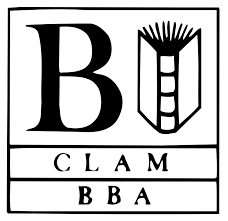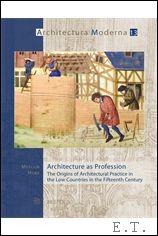Nieuw binnengekomen
HURX, Merlijn.
Architecture as profession.The origins of architectural practice in the Low Countries in the fifteenth century.
Brepols, 2018.. Paperback, 459 pages ., 265 b/w ill. + 16 colour ill., 5 b/w tables, 220 x 280 mm,
Languages: English. Fifteenth-century Florence is generally considered the cradle of the modern architect. There, for the first time since Antiquity, the Vitruvian concept which distinguishes between builder and designer was recognised in architectural theory, causing a fundamental rupture in architectural practice. In this well-established narrative Northern Europe only followed a century later when, along with the diffusion of Italian treatises and the introduction of the all?antica style, a new type of architect began to replace traditional gothic masters. However, historiography has largely overlooked the important transformations in building organisation that laid the foundations for our modern architectural production, such as the advent of affluent contractors, public tenders, and specialised architectural designers, all of which happened in fifteenth-century Northern Europe. Drawing on a wealth of new source material from the Low Countries, this book offers a new approach to the transition from the Middle Ages to the Early Modern Period by providing an alternative interpretation to the predominantly Italo-centric perspective of the current literature, and its concomitant focus on style and on Vitruvian theory. Merlijn Hurx is assistant professor of architectural history at Utrecht University. He is specialised in fifteenth- and sixteenth-century architecture in the Low Countries. Table of Contents Introduction Professionalisation in the nineteenth and early twentieth centuries and the ideal of the architect Economics and the position of the architect Design and construction Different sources, methods and approaches Approach and structure of the book Chapter 1. The liberty to design Defining the architect Designs for different media Liberal arts and the guilds? monopoly Patrons and guild authority Constelyk gemaickt, artistic quality as a licence Chapter 2. Urban building boom Urbanisation in the Low Countries City walls City churches Trade halls and town halls Princely residences Urban architectural rivalry Chapter 3. The stone trade The need for stone Contracting building works Benefits of the market Expanding markets Innovations in the production process Managing the stone trade Chapter 4. Quarrying at Brussels Stones and quarries Commercial importance and stone politics Brussels entrepreneurs in stone: Godevaert de Bosschere and Lodewijk van Boghem Chapter 5. Profession of the architect Background and training Changing conditions of employment Evert Spoorwater and Rombout Keldermans Undermasters and methods of communication Engineer, manager, designer Chapter 6. Communicating the design The drawing as planning instrument Innovations in architectural representation The design in words Chapter 7. Strategies for ?prefab? architecture Plain architecture by prominent architects Repeated designs Conclusion Epilogue Appendices 1. Money and measurements 2. Projects by Evert Spoorwater, sources of table 5.1 3. Projects by Rombout Keldermans, sources of table 5.2 EUR 95.00
Languages: English. Fifteenth-century Florence is generally considered the cradle of the modern architect. There, for the first time since Antiquity, the Vitruvian concept which distinguishes between builder and designer was recognised in architectural theory, causing a fundamental rupture in architectural practice. In this well-established narrative Northern Europe only followed a century later when, along with the diffusion of Italian treatises and the introduction of the all?antica style, a new type of architect began to replace traditional gothic masters. However, historiography has largely overlooked the important transformations in building organisation that laid the foundations for our modern architectural production, such as the advent of affluent contractors, public tenders, and specialised architectural designers, all of which happened in fifteenth-century Northern Europe. Drawing on a wealth of new source material from the Low Countries, this book offers a new approach to the transition from the Middle Ages to the Early Modern Period by providing an alternative interpretation to the predominantly Italo-centric perspective of the current literature, and its concomitant focus on style and on Vitruvian theory. Merlijn Hurx is assistant professor of architectural history at Utrecht University. He is specialised in fifteenth- and sixteenth-century architecture in the Low Countries. Table of Contents Introduction Professionalisation in the nineteenth and early twentieth centuries and the ideal of the architect Economics and the position of the architect Design and construction Different sources, methods and approaches Approach and structure of the book Chapter 1. The liberty to design Defining the architect Designs for different media Liberal arts and the guilds? monopoly Patrons and guild authority Constelyk gemaickt, artistic quality as a licence Chapter 2. Urban building boom Urbanisation in the Low Countries City walls City churches Trade halls and town halls Princely residences Urban architectural rivalry Chapter 3. The stone trade The need for stone Contracting building works Benefits of the market Expanding markets Innovations in the production process Managing the stone trade Chapter 4. Quarrying at Brussels Stones and quarries Commercial importance and stone politics Brussels entrepreneurs in stone: Godevaert de Bosschere and Lodewijk van Boghem Chapter 5. Profession of the architect Background and training Changing conditions of employment Evert Spoorwater and Rombout Keldermans Undermasters and methods of communication Engineer, manager, designer Chapter 6. Communicating the design The drawing as planning instrument Innovations in architectural representation The design in words Chapter 7. Strategies for ?prefab? architecture Plain architecture by prominent architects Repeated designs Conclusion Epilogue Appendices 1. Money and measurements 2. Projects by Evert Spoorwater, sources of table 5.1 3. Projects by Rombout Keldermans, sources of table 5.2 EUR 95.00









